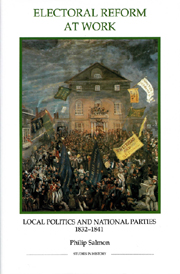Book contents
- Frontmatter
- Contents
- List of illustrations
- List of figures
- List of tables
- Dedication
- Acknowledgements
- Abbreviations
- Introduction
- PART I THE REFORMED ELECTORAL SYSTEM
- PART II THE COUNTIES
- 4 Electoral behaviour in the counties: influence and independence
- 5 County politics and registration: case studies
- PART III THE BOROUGHS
- Appendices
- Bibliography
- Index
4 - Electoral behaviour in the counties: influence and independence
from PART II - THE COUNTIES
Published online by Cambridge University Press: 12 September 2012
- Frontmatter
- Contents
- List of illustrations
- List of figures
- List of tables
- Dedication
- Acknowledgements
- Abbreviations
- Introduction
- PART I THE REFORMED ELECTORAL SYSTEM
- PART II THE COUNTIES
- 4 Electoral behaviour in the counties: influence and independence
- 5 County politics and registration: case studies
- PART III THE BOROUGHS
- Appendices
- Bibliography
- Index
Summary
Much attention has recently been focused on re-examining the electoral dynamics of borough constituencies, both before and after 1832. By contrast, there has been a marked absence of similar revisionist work on the reformed rural electorate. This is surprising given that the existing literature is so sharply divided into two schools of thought. First, there are the detailed local studies which tend to stress the importance of issues and the active political agency of individual voters in determining patterns of rural voting after 1832. The variety and particularism of these political issues, however, has made it difficult to draw any general conclusions about the nature and operation of the county electoral system as a whole. Indeed, most of these local studies have been at pains to point out regional idiosyncrasy and abnormality. Richard Olney, for example, warned that Lincolnshire was not ‘typical of the majority of English counties; nor was it, perhaps, typical even of the rural counties’. Tom Nossiter came to a similar conclusion about County Durham, insisting that ‘the north-east was isolated from the rest of the country; it diverged from the national pattern in both the structure of landownership and the nature of agriculture’. Likewise Edwin Jaggard's recent analysis of Cornwall politics portrayed ‘a political culture different in some ways from the remainder of England’. As Richard Davis suggested in his study of Buckinghamshire, ‘no county, after all, is exactly like any other county’.
- Type
- Chapter
- Information
- Electoral Reform at WorkLocal Politics and National Parties, 1832–1841, pp. 119 - 145Publisher: Boydell & BrewerPrint publication year: 2002

